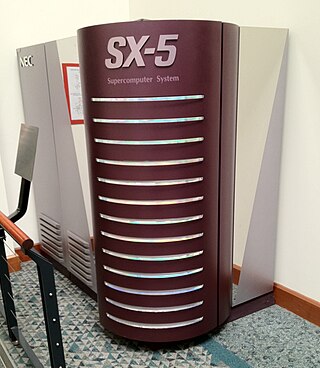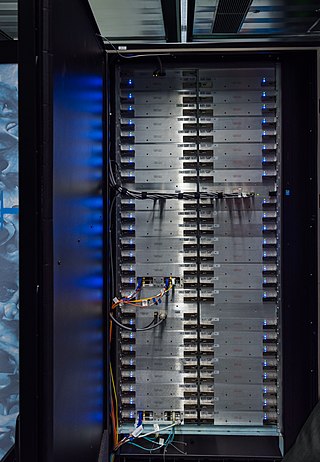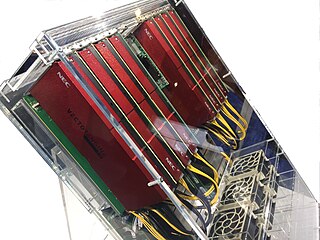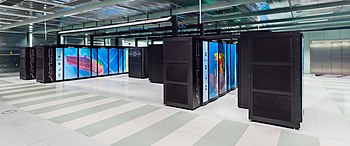
A supercomputer is a computer with a high level of performance as compared to a general-purpose computer. The performance of a supercomputer is commonly measured in floating-point operations per second (FLOPS) instead of million instructions per second (MIPS). Since 2017, there have existed supercomputers which can perform over 1017 FLOPS (a hundred quadrillion FLOPS, 100 petaFLOPS or 100 PFLOPS). For comparison, a desktop computer has performance in the range of hundreds of gigaFLOPS (1011) to tens of teraFLOPS (1013). Since November 2017, all of the world's fastest 500 supercomputers run on Linux-based operating systems. Additional research is being conducted in the United States, the European Union, Taiwan, Japan, and China to build faster, more powerful and technologically superior exascale supercomputers.
In computing, floating point operations per second is a measure of computer performance, useful in fields of scientific computations that require floating-point calculations. For such cases, it is a more accurate measure than measuring instructions per second.
The Earth Simulator (ES) is a series of supercomputers deployed at Japan Agency for Marine-Earth Science and Technology Yokohama Institute of Earth Sciences.

Blue Gene was an IBM project aimed at designing supercomputers that can reach operating speeds in the petaFLOPS (PFLOPS) range, with low power consumption.
Cray Inc., a subsidiary of Hewlett Packard Enterprise, is an American supercomputer manufacturer headquartered in Seattle, Washington. It also manufactures systems for data storage and analytics. Several Cray supercomputer systems are listed in the TOP500, which ranks the most powerful supercomputers in the world.

NEC SX describes a series of vector supercomputers designed, manufactured, and marketed by NEC. This computer series is notable for providing the first computer to exceed 1 gigaflop, as well as the fastest supercomputer in the world between 1992–1993, and 2002–2004. The current model, as of 2018, is the SX-Aurora TSUBASA.

EPCC, formerly the Edinburgh Parallel Computing Centre, is a supercomputing centre based at the University of Edinburgh. Since its foundation in 1990, its stated mission has been to accelerate the effective exploitation of novel computing throughout industry, academia and commerce.

The National Energy Research Scientific Computing Center (NERSC), is a high-performance computing (supercomputer) National User Facility operated by Lawrence Berkeley National Laboratory for the United States Department of Energy Office of Science. As the mission computing center for the Office of Science, NERSC houses high performance computing and data systems used by 9,000 scientists at national laboratories and universities around the country. Research at NERSC is focused on fundamental and applied research in energy efficiency, storage, and generation; Earth systems science, and understanding of fundamental forces of nature and the universe. The largest research areas are in High Energy Physics, Materials Science, Chemical Sciences, Climate and Environmental Sciences, Nuclear Physics, and Fusion Energy research. NERSC's newest and largest supercomputer is Perlmutter, which debuted in 2021 ranked 5th on the TOP500 list of world's fastest supercomputers.

ProLiant is a brand of server computers that was originally developed and marketed by Compaq and currently marketed by Hewlett Packard Enterprise. After Compaq merged with Hewlett-Packard (HP), HP retired its NetServer brand in favor of the ProLiant brand. HP ProLiant systems led the x86 server market in terms of units and revenue during first quarter of 2010. The HP ProLiant servers offer many advanced server features such as redundant power supplies, Out-of-band management with iLO or Lights-out 100, Hot-swap components and up to 8-Socket systems.
The Oak Ridge Leadership Computing Facility (OLCF), formerly the National Leadership Computing Facility, is a designated user facility operated by Oak Ridge National Laboratory and the Department of Energy. It contains several supercomputers, the largest of which is an HPE OLCF-5 named Frontier, which was ranked 1st on the TOP500 list of world's fastest supercomputers as of June 2022. It is located in Oak Ridge, Tennessee.

The TOP500 project ranks and details the 500 most powerful non-distributed computer systems in the world. The project was started in 1993 and publishes an updated list of the supercomputers twice a year. The first of these updates always coincides with the International Supercomputing Conference in June, and the second is presented at the ACM/IEEE Supercomputing Conference in November. The project aims to provide a reliable basis for tracking and detecting trends in high-performance computing and bases rankings on HPL benchmarks, a portable implementation of the high-performance LINPACK benchmark written in Fortran for distributed-memory computers.
Shaheen is the name of a series of supercomputers owned and operated by King Abdullah University of Science and Technology (KAUST), Saudi Arabia. Shaheen is named after the Peregrine Falcon. The most recent model, Shaheen II, is the largest and most powerful supercomputer in the Middle East.
The Swiss National Supercomputing Centre is the national high-performance computing centre of Switzerland. It was founded in Manno, canton Ticino, in 1991. In March 2012, the CSCS moved to its new location in Lugano-Cornaredo.

The Minnesota Supercomputing Institute (MSI) in Minneapolis, Minnesota is a core research facility of the University of Minnesota that provides hardware and software resources, as well as technical user support, to faculty and researchers at the university and at other institutions of higher education in Minnesota. MSI is located in Walter Library, on the university's Twin Cities campus.

Japan operates a number of centers for supercomputing which hold world records in speed, with the K computer becoming the world's fastest in June 2011. and Fugaku took the lead in June 2020, and furthered it, as of November 2020, to 3 times faster than number two computer.

Several centers for supercomputing exist across Europe, and distributed access to them is coordinated by European initiatives to facilitate high-performance computing. One such initiative, the HPC Europa project, fits within the Distributed European Infrastructure for Supercomputing Applications (DEISA), which was formed in 2002 as a consortium of eleven supercomputing centers from seven European countries. Operating within the CORDIS framework, HPC Europa aims to provide access to supercomputers across Europe.

The Cray XC40 is a massively parallel multiprocessor supercomputer manufactured by Cray. It consists of Intel Haswell Xeon processors, with optional Nvidia Tesla or Intel Xeon Phi accelerators, connected together by Cray's proprietary "Aries" interconnect, stored in air-cooled or liquid-cooled cabinets. The XC series supercomputers are available with the Cray DataWarp applications I/O accelerator technology.

The Hewlett Packard Enterprise Company (HPE) is an American multinational information technology company based in Spring, Texas, United States.
The Cray XC50 is a massively parallel multiprocessor supercomputer manufactured by Cray. The machine can support Intel Xeon processors, as well as Cavium ThunderX2 processors, Xeon Phi processors and NVIDIA Tesla P100 GPUs. The processors are connected by Cray's proprietary "Aries" interconnect, in a dragonfly network topology. The XC50 is an evolution of the XC40, with the main difference being the support of Tesla P100 processors and the use of Cray software release CLE 6 or 7.

The NEC SX-Aurora TSUBASA is a vector processor of the NEC SX architecture family. Unlike previous SX supercomputers, the SX-Aurora TSUBASA is provided as a PCIe card, termed by NEC as a "Vector Engine" (VE). Eight VE cards can be inserted into a vector host (VH) which is typically a x86-64 server running the Linux operating system. The product has been announced in a press release on 25 October 2017 and NEC has started selling it in February 2018. The product succeeds the SX-ACE.













